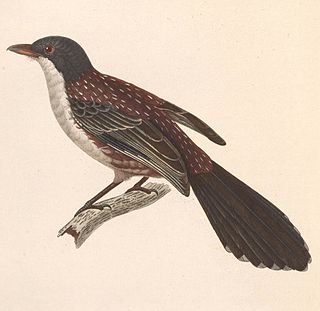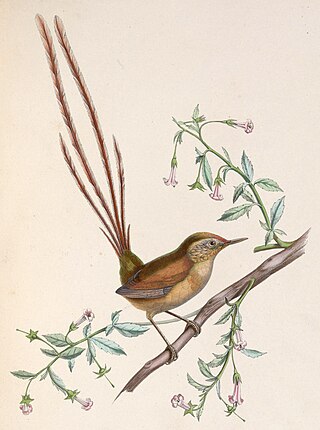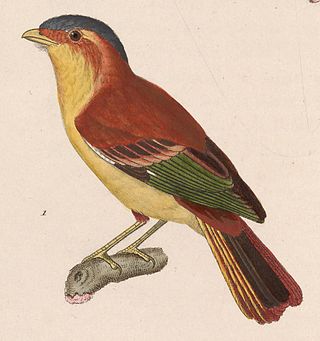
The genus Nestor is one of the two extant genera of the parrot family Strigopidae. Together with the kākāpō, and the extinct parrots in the genus Nelepsittacus, they form the parrot superfamily Strigopoidea. The Nestor's genus contains two extant parrot species from New Zealand and two extinct species from Norfolk Island, Australia and Chatham Island, New Zealand, respectively. All species are large stocky birds with short squarish tails. A defining characteristic of the genus is the tongue, which is tipped with a hair-like fringe. The superficial resemblance of this tongue to that of lorikeets has led some taxonomists to consider the two groups closely related, but DNA evidence shows they are not.

The buntings are a group of Old World passerine birds forming the genus Emberiza, the only genus in the family Emberizidae. The family contains 44 species. They are seed-eating birds with stubby, conical bills.

Sylviidae is a family of passerine birds that includes the typical warblers Sylvia, and closely related genus Curruca, formerly included in Sylvia. They are found in Eurasia and Africa, with the greatest diversity in the Mediterranean region.

The Old World flycatchers are a large family, the Muscicapidae, of small passerine birds restricted to the Old World, with the exception of several vagrants and two species, bluethroat and northern wheatear, found also in North America. These are mainly small arboreal insectivores, many of which, as the name implies, take their prey on the wing. The family is relatively large and includes 357 species, which are divided into 54 genera.

Garrulax is a genus of passerine birds in the laughingthrush family Leiothrichidae.

Leiothrix is a genus of passerine birds in the family Leiothrichidae. They belong to a clade also containing at least the liocichlas, barwings, minlas and sibias. The sibias are possibly their closest living relatives.

Pyrocephalus is a genus of bird in the tyrant flycatcher family, Tyrannidae.

Lophorina is a genus of birds in the birds-of-paradise family Paradisaeidae that are endemic to New Guinea, formerly containing a single species, but as of 2017, containing three species.

The Bugun liocichla is a passerine bird species from the family Leiothrichidae closely related to the Emei Shan liocichla. First spotted in 1995 in Arunachal Pradesh, India, it was described as a new species in 2006. The description was made without the collection of a type specimen as they were too few to risk killing one. It is thought to be an endangered species, with a small population, and a very restricted distribution range within which commercial development threatens the habitat.

The spotted crocias is a passerine bird in the family Leiothrichidae. It is endemic to the island of Java in Indonesia, where it is confined to west Java.
The grey-crowned crocias is a passerine bird in the family Leiothrichidae. It is endemic to Vietnam, where it has a highly restricted distribution in the Da Lat Plateau. It has also been observed, and independently surveyed in 2015, in Central Vietnam on the Kontum Plateau, where it may be more abundant. Its natural habitat is intact broadleaf evergreen forest and secondary forest, generally near watercourses, between 910–1450 m above sea-level.

The purple-naped spiderhunter or purple-naped sunbird is a species of bird in the family Nectariniidae. It is the only species in the genus Kurochkinegramma. It is found in Southeast Asia from Myanmar to Sumatra and Borneo. Its natural habitat is subtropical or tropical moist lowland forests.

Des Murs's wiretail is a small passerine bird of southern South America which belongs to the ovenbird family Furnariidae. Molecular phylogenetics places it within the Synallaxinae and indicates that the genus diverged from the Leptasthenura about 14-15 million years ago.

Piprites is a genus of bird currently placed in the family Tyrannidae. Prior to 1971, the genus was placed in the family Pipridae; its designation was initially changed based on morphological evidence, and genetic evidence confirmed its placement in 2009. In 2013, it was proposed that Piprites was to be placed in the unique family Pipritinae. The proposition was declined by the Comité de Clasificación de Sudamérica, a part of the American Ornithological Society, and the proposed family was changed to be a unique subfamily of the genus. The genus is composed of three species native to the neotropical realm, with distributions ranging from the Caribbean coast of Guatemala, Central America, and southeastern Argentina.

Trochalopteron is a genus of passerine birds in the laughingthrush family Leiothrichidae.

Argya is a genus of passerine birds in the laughingthrush family Leiothrichidae. The species are distributed across Africa and southern Asia and are typically fairly large, long-tailed birds that forage in noisy groups. Members of this genus were formerly placed in the genera Turdoides and Garrulax.

The laughingthrushes are a family, Leiothrichidae, of Old World passerine birds. The family contains 133 species which are divided into 16 genera. They are diverse in size and coloration. These are birds of tropical areas, with the greatest variety in Southeast Asia and the Indian subcontinent. The entire family used to be included in the Old World babbler family Timaliidae.

Clanga is a genus which contains the spotted eagles. The genus name is from Ancient Greek klangos, "eagle".

Gymnoris is a genus of passerine birds in the sparrow family Passeridae. Three species are found in Africa while the yellow-throated sparrow ranges from Turkey to India.

Ianthocincla is a genus of passerine birds in the family Leiothrichidae.


















